Articles
- Page Path
- HOME > Korean J Community Nutr > Volume 24(2); 2019 > Article
-
Research Article
- Study on Middle and High School Students' Use of Convenience Foods at Convenience Stores in Incheon
-
Seul-Ki Lee
 , Mi-Kyeong Choi
, Mi-Kyeong Choi , Mi-Hyun Kim
, Mi-Hyun Kim
-
Korean Journal of Community Nutrition 2019;24(2):137-151.
DOI: https://doi.org/10.5720/kjcn.2019.24.2.137
Published online: April 30, 2019
1Major in Nutrition Education, Graduate School of Education, Kongju National University, Yesan 32439, Korea, Graduate student.
2Division of Food Science, Kongju National University, Yesan 32439, Korea, Professor.
- Corresponding author: Mi-Hyun Kim. Division of Food Science, Kongju National University, Yesan 32439, Korea. Tel: (041) 330-1463, Fax: (041) 330-1469, mhkim1129@kongju.ac.kr
Copyright © 2019 The Korean Society of Community Nutrition
This is an Open-Access article distributed under the terms of the Creative Commons Attribution Non-Commercial License (http://creativecommons.org/licenses/by-nc/3.0/) which permits unrestricted non-commercial use, distribution, and reproduction in any medium, provided the original work is properly cited.
- 615 Views
- 6 Download
- 7 Crossref
Abstract
-
Objectives
- The rapidly changing dietary environment requires a study that addresses the status of middle and high school students regarding their consumption of convenience food sold at convenience stores.
-
Methods
- This study examined adolescents' lifestyle patterns, dietary habits, and status of consuming convenience food at convenience stores. A total of 659 students (329 middle school students and 330 high school students) in Incheon participated in this questionnaire survey.
-
Results
- The mean age of the subjects was 13.7 years for the middle school students, and 16.6 years for the high school students. The gender and grade distributions in the middle and high school students were similar. The middle school students reported that they spent more time using electronic devices (p<0.001) or watching TV (p<0.001) than high school students. More than 60% of middle and high school students consumed convenience food at convenience stores without statistical difference between the two groups. The main reason for consuming convenience food from convenience stores was its convenience followed by taste in both groups. Despite the high frequency of consuming convenience food, the students rarely checked the nutrition labels at the time of purchase. On the other hand, they were still most concerned about the nutritional value of the convenience foods when they consumed convenience foods. The most frequently consumed convenience food was ramyon in both groups. Significant positive correlations were observed between the frequency of consuming convenience food at convenience stores and lifestyle factors for the middle school students, including monthly allowance, time for using electronic devices, and number of private lessons. For the high school students, however, the only monthly allowance had a significant positive correlation with the consumption.
-
Conclusions
- Adolescents are increasingly exposed to convenience foods and relevant nutritional issues are a concern. Therefore, a dietary environment that is adequately formed for the healthy development of youth as well as systematic nutrient education that is appropriately designed for both middle and high school students is required.
- 1. Ministry of Health and Welfare. Korea Centers for Disease Control & Prevention. Korea health statistics 2016: Korea National Health and Nutrition Examination Survey (KNHANES VII-1). Cheongju: Korea Centers for Disease Control & Prevention; 2017.
- 2. Ministry of Education. Ministry of Health and Welfare. Korea Centers for Disease Control & Prevention. The 13th Korea youth risk behavior web-based survey. Cheongju: Korea Centers for Disease Control & Prevention; 2017.
- 3. Korea Association of Convenience Store Industry. Convenience store industry status [internet]. Korea Association of Convenience Store Industry; 2013; 2017; cited 2018 November 13]. Available from: http://www.cvs.or.kr/Board/Board_List.php?DB=B_com7.
- 4. Shin GN, Kim YR, Kim MH. Nutritional evaluation of convenience meals in convenience stores near the universities. Korean J Community Nutr 2017; 22(5): 375-386.ArticlePDF
- 5. Pae M. Dietary habits and perception toward food additives according to the frequency of consumption of convenience food at convenience stores among university students in Cheongju. Korean J Community Nutr 2016; 21(2): 140-151.ArticlePDF
- 6. Kim HY, Lee JS, Hwang JY, Kwon SH, Chung HR, Kwak TK. Development of NQ-A, Nutrition Quotient for Korean Adolescents, to assess dietary quality and food behavior. J Nutr Health 2017; 50(2): 142-157.ArticlePDF
- 7. Choi MK. A study on the relationship between fast food consumption patterns and nutrition knowledge, dietary attitude of middle and high school students in Busan. Korean J Culinary Res 2007; 13(2): 188-200.Article
- 8. Yang KM. A study on the anthropometric characteristics, dietary attitudes and nutritional knowledge among high school students in Daegu area. J Glob Youth Stud 2013; 3(2): 45-65.
- 9. Yoon SY, Yoo HS. The effects of food and nutrition information in mass media on adolescents' dietary behaviors. J Korean Soc Integr Med 2016; 4(2): 109-120.Article
- 10. Korean Statistical Information Service. Investigation of private education expenses in elementary, middle, and high schools [internet]. Statistics Korea; 2018; cited Apr 17]. Available from: http://kosis.kr/statisticsList/statisticsListIndex.do?menuId=M_01_01&vwcd=MT_ZTITLE#SelectStatsBoxDiv.
- 11. Kwon JE, Park HJ, Lim HS, Chyun JH. The relationships of dietary behavior, food intake, and life satisfaction with family meal frequency in middle school students. J Korean Soc Food Cult 2013; 28(3): 272-281.Article
- 12. Choi KI. An effect on body image of time of television watching and Internet use for academic high school students. J Adolesc Welf 2013; 15(3): 173-191.
- 13. Boynton-Jarrett R, Thomas TN, Peterson KE, Wiecha J, Sobol AM, Gortmaker SL. Impact of television viewing patterns on fruit and vegetable consumption among adolescents. Pediatrics 2003; 112(6): 1321-1326.ArticlePubMedPDF
- 14. Ma Y, Bertone ER, Stanek EJ 3rd, Reed GW, Hebert JR, Cohen NL. Association between eating patterns and obesity in a free-living U.S. adult population. Am J Epidemiol 2003; 158(1): 85-92.ArticlePubMed
- 15. Park KW, Lee K, Park TJ, Kwon ER, Ha SJ, Moon HJ. The factors associated with becoming obese children: in 6th grade children of elementary schools in Busan. J Korean Acad Fam Med 2003; 24(8): 739-745.
- 16. Zhang L. How game addiction and smartphone addiction affects teens physical health [Master's thesis]. Myongji University; 2013.
- 17. Lee NN. A research on the impact of eating behavior and food intake according to the gender and smartphone addiction [Master's thesis]. KyungHee University; 2014.
- 18. Erdenebileg Z, Park SH, Park SJ, Chang KJ. Nutrition knowledge, dietary attitudes, and dietary behaviors by gender of high school students in Incheon. J Korean Soc Food Cult 2016; 31(6): 652-660.Article
- 19. Han GS, Cho WK. Study of dietary behaviors and snack intake patterns of high school students in Seoul, Incheon, and Gyeonggi-do. Korean J Food Cult 2011; 26(5): 490-500.
- 20. Park HR, Kim JH, Lee JH. Socio-demographic influences on adolescents' eating behavior: based on the Korean youth risk web-based survey from 2015. J Korean Diet Assoc 2017; 23(4): 397-407.
- 21. Yoon HS. The consumption pattern, perception and knowledge of middle and high school students on milk in Geochang area. J Korean Diet Assoc 2006; 12(1): 18-31.
- 22. Kim NY, Lee JS. A study on perception and utilization of food-nutrition labeling by age in Busan residents. J Korean Soc Food Sci Nutr 2009; 38(12): 1801-1810.Article
- 23. Koo HJ, Kim SY. Analysis of purchasing behaviors of processed foods in high school students in Yongin region. J Korean Soc Food Sci Nutr 2014; 43(12): 1929-1936.Article
- 24. Ko SY, Kim KW. Nutrition label use, self-efficacy, snacking and eating behavior of middle school students in Kyunggi area. Korean J Community Nutr 2010; 15(4): 513-524.
- 25. Jung EY, Lim YH, Park MS, Kim MW. A survey of the consumption of convenience foods. Korean J Community Nutr 2002; 7(2): 149-155.
- 26. Choi H, Kwon S, Yoon J. Government-funded meal support program for low-income children through convenience stores: current status and nutritional quality of available meal items in Seoul. Korean J Community Nutr 2011; 16(2): 253-264.Article
- 27. Jung LH, Kim YJ, Jeon ER. A study on snack purchasing behavior, understanding of food and nutrition labeling of middle school students in Naju area. J Korean Home Econ Educ Assoc 2014; 26(4): 1-19.
- 28. Kim KH. A study of the dietary habits, the nutritional knowledge and the consumption patterns of convenience foods of university students in the Gwangju area. Korean J Community Nutr 2003; 8(2): 181-191.
REFERENCES
Status of checking nutrition labeling when using convenience food in convenience stores of the middle and highschool students
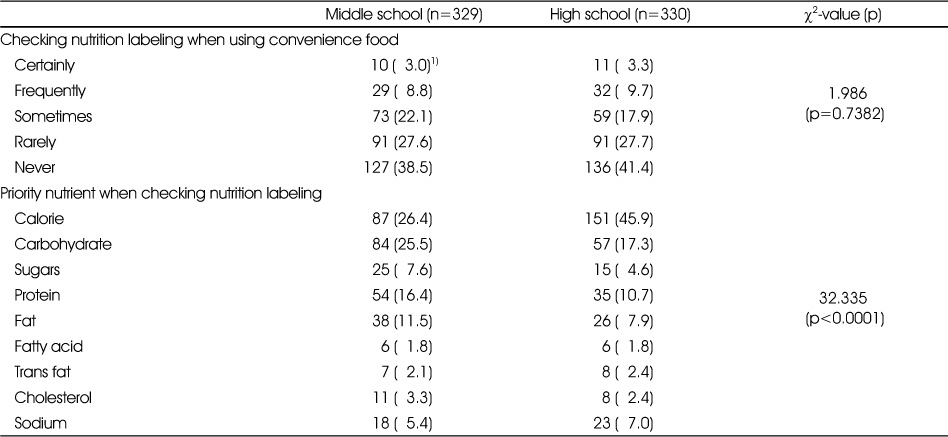
Reasons and concerns on using convenience food at convenience stores of the middle and highschool students

Figure & Data
REFERENCES
Citations

- Gen Z consumers’ expectations for smart convenience stores in the USA, South Korea, and Japan
Summer Dahyang Jung, Sahej Claire, Sohyeong Kim
Young Consumers.2024; 25(3): 400. CrossRef - Study on the Eating Out Behavior and the Status of Meal Delivery and Take-Out Consumption according to the Food-related Lifestyles of Adolescents : Using the Consumption Behavior Survey for Food in 2020
Eun Jung Lee, Hyeon Min Yang, Yeong Ju Lee, Sun A Choi, Jeong Ok Rho
Journal of the East Asian Society of Dietary Life.2024; 34(4): 284. CrossRef - The frequency of convenience food consumption and attitude of sodium and sugar reduction among middle and high school students in Seoul: a descriptive study
Seoyeon Park, Yeonhee Shin, Seoyeon Lee, Heejung Park
Korean Journal of Community Nutrition.2023; 28(4): 269. CrossRef - Determination of the migration of plastic additives and non-intentionally added substances into food simulants and the assessment of health risks from convenience food packaging
Eun Chul Pack, Kyung Youn Lee, Jin Seop Jung, Dae Yong Jang, Hyung Soo Kim, Ye Ji Koo, Ho Geon Lee, Young Soon Kim, Kyung Min Lim, Seung Ha Lee, Dal Woong Choi
Food Packaging and Shelf Life.2021; 30: 100736. CrossRef - Association between breakfast and lifestyle, interest in beauty care, and attitude toward breakfast in high school girls in Incheon
Seolmi Lee, Mi-Hyun Kim
Journal of Nutrition and Health.2020; 53(3): 288. CrossRef - Convenience Store Use and the Health of Urban Adolescents in Seoul, South Korea
Nan-He Yoon, Changwoo Shon
International Journal of Environmental Research and Public Health.2020; 17(18): 6486. CrossRef - Association between frequency of convenience foods use at convenience stores and dietary quality among high school students in Incheon
Eun-Mi Kim, Mi-Kyeong Choi, Mi-Hyun Kim
Journal of Nutrition and Health.2019; 52(4): 383. CrossRef
General characteristics of the middle and highschool students
1) Mean ± SD
2) n (%)
†: t-value
Dietary habits of the middle and highschool students
1) n (%)
Status of using convenience food at convenience stores of the middle and highschool students
1) n (%)
Status of checking nutrition labeling when using convenience food in convenience stores of the middle and highschool students
1) n (%)
Reasons and concerns on using convenience food at convenience stores of the middle and highschool students
1) n (%)
Intake frequency for each type of convenience food in convenience stores of the middle and highschool students
1) n (%)
Correlation between frequency of consuming convenience food from convenience stores and lifestyle factors
1) *: p<0.05, ***: p<0.001
1) Mean ± SD 2) n (%) †: t-value
1) n (%)
1) n (%)
1) n (%)
1) n (%)
1) n (%)
1) *: p<0.05, ***: p<0.001

 KSCN
KSCN
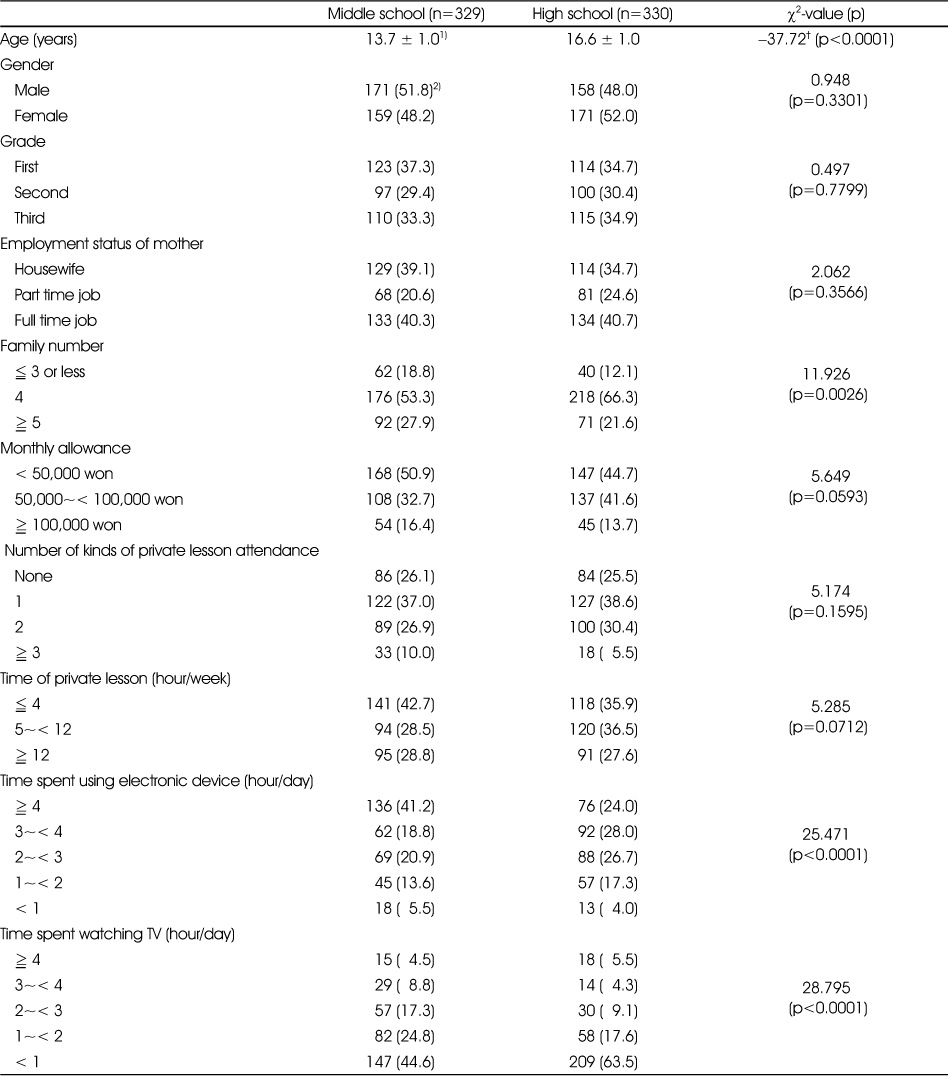
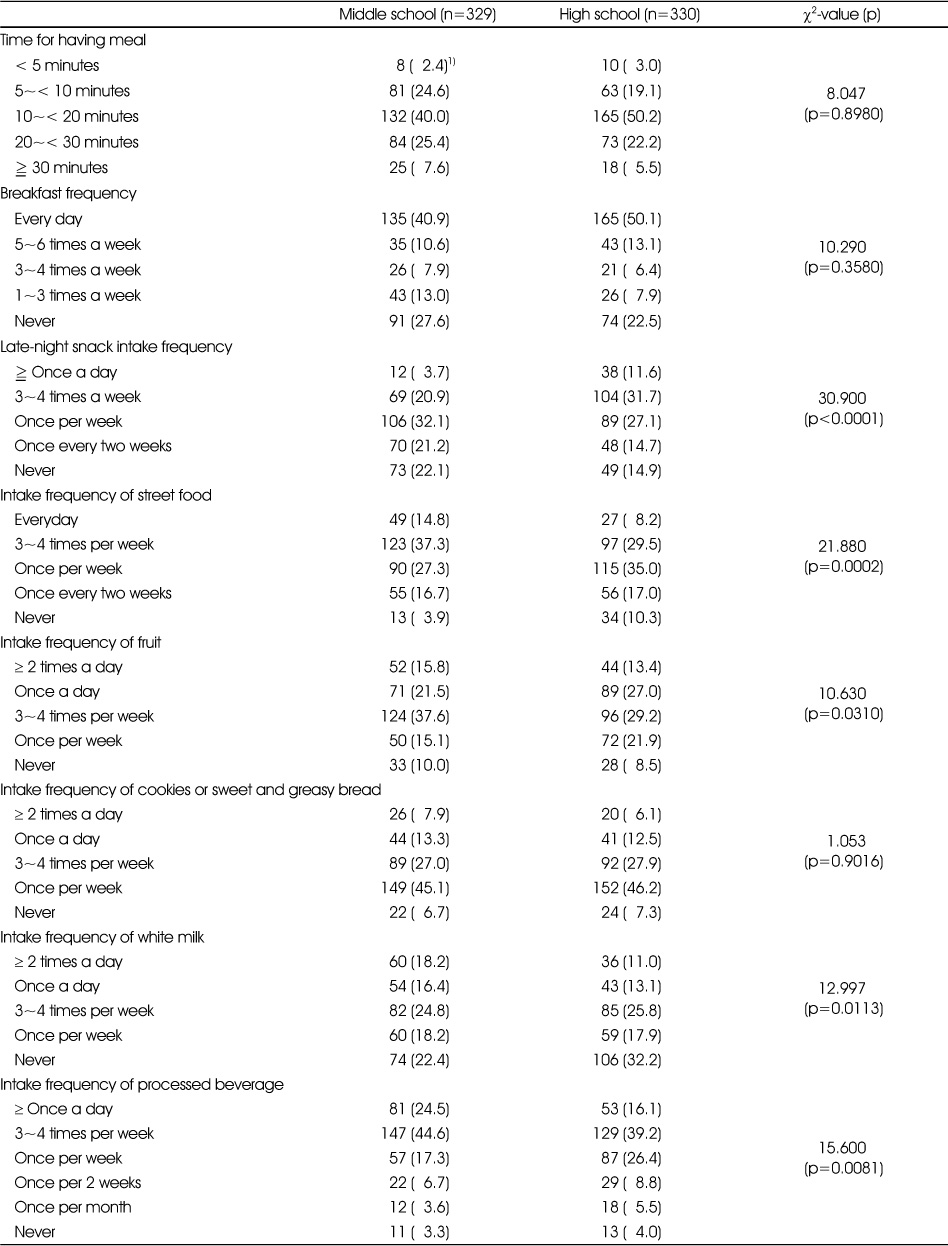
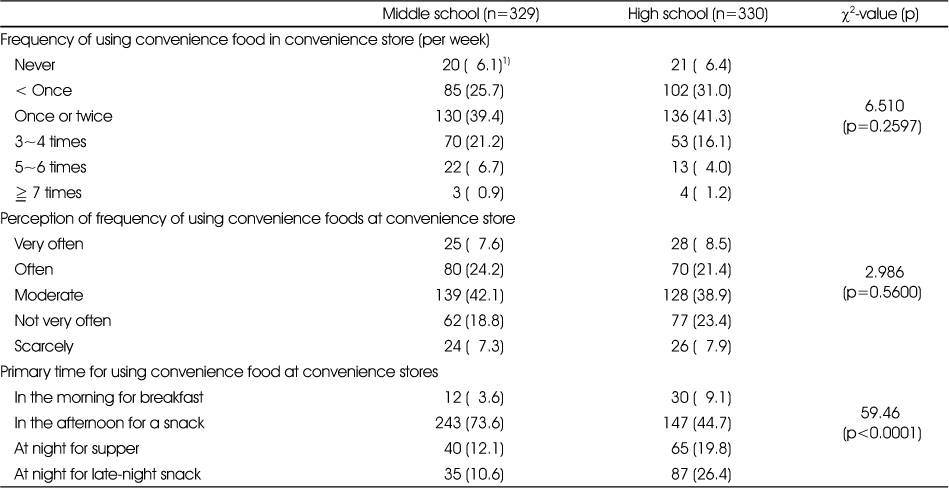
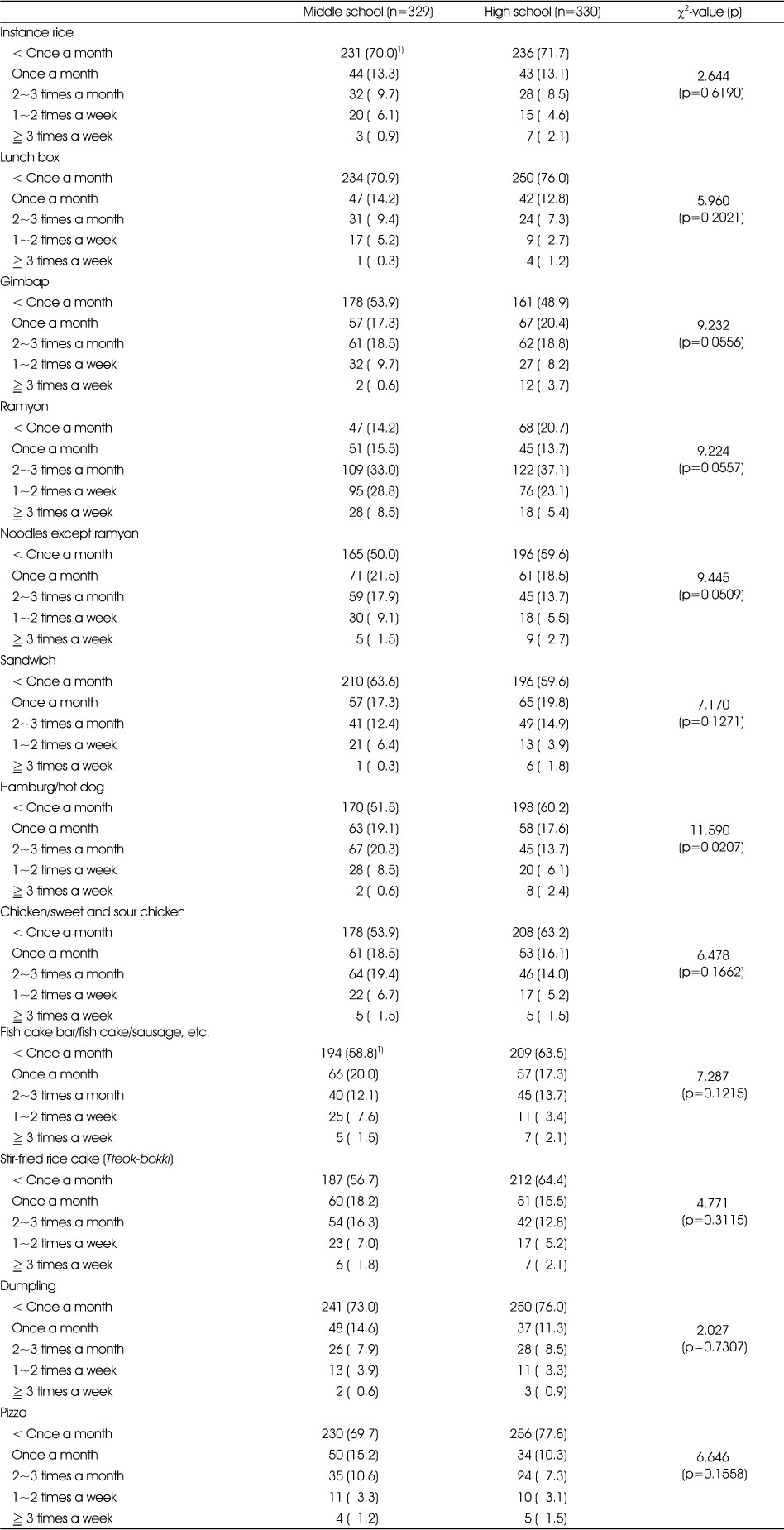

 PubReader
PubReader Cite
Cite


